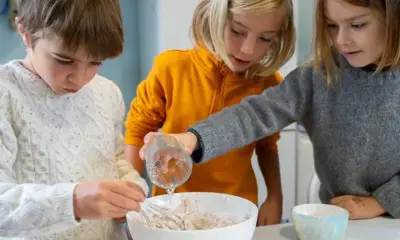Food & Nutrition
The Role of Potassium in Your Child’s Diet

Why Potassium in Child’s Diet Matters for Growth and Development
Every growing child needs essential nutrients. One of the most important nutrients is potassium. This mineral supports many vital body functions.
In fact, potassium in child’s diet ensures healthy development, muscle function, and proper heart rhythm. Let’s explore why it matters so much.
The Importance of Potassium for Kids
Potassium helps control the body’s water balance. It works with sodium to regulate fluids and blood pressure efficiently.
A diet low in potassium and high in sodium may increase the risk of high blood pressure, even in young kids.
Additionally, potassium supports strong muscle function and healthy heart rhythms, which are critical for growing children.
Later in life, potassium can lower the risk of kidney stones and osteoporosis. That’s why early intake is very important.
Unfortunately, the American Dietetic Association found many school-age children don’t get enough potassium in their diet.
How Much Potassium Does Your Child Need?
Your child’s potassium needs vary by age. Young kids and school-aged children have different daily requirements.
- Ages 1 to 3 years: 3,000 milligrams per day
- Ages 4 to 8 years: 3,800 milligrams per day
They don’t need to meet the exact number daily. Instead, aim for the average over a few days each week.
Best Natural Sources of Potassium
Thankfully, many everyday foods offer a healthy dose of potassium. Fresh fruits and vegetables rank highest among these options.
Dairy, meats, and cereals also contain potassium, but the body absorbs it less efficiently from these sources.
Top Potassium-Rich Foods
- 1/2 medium baked potato: 463 mg
- 1/2 cup prune juice: 352 mg
- 1/4 cup prunes: 318 mg
- 1/4 cup raisins: 299 mg
- 1/2 cup tomato juice: 278 mg
- 1/4 cup white beans: 251 mg
- 1/2 cup orange juice: 248 mg
- 1/4 cup lima beans: 242 mg
- 1 ounce sunflower seeds: 241 mg
- 1/4 cup acorn squash: 224 mg
- 1/2 medium banana: 211 mg
- 1/4 cup cooked spinach: 210 mg
- 1/2 cup cantaloupe: 208 mg
- 1 ounce almonds: 200 mg
- 1/2 medium tomato: 146 mg
- 1/2 cup bran cereal with raisins: 181 mg
- 1/2 medium orange: 118 mg
- 1/4 cup honeydew: 97 mg
- 2 deglet noor dates: 94 mg
- 1/2 cup watermelon: 85 mg
These nutritious options make it easier to boost potassium in child’s diet without using supplements or packaged foods.
Just remember, serving sizes and potassium content vary slightly by fruit size or product brand. Always check the label if possible.
Also, avoid giving whole nuts or dried fruits to toddlers. These foods can pose choking hazards. Spread nut butter thinly instead.
Can Kids Get Too Much Potassium?
Yes, though it’s rare. Most healthy children don’t consume excessive potassium through food alone.
There is no official upper intake limit from the Institute of Medicine. However, maintaining potassium balance remains essential.
Too much potassium may lead to hyperkalemia, which can cause muscle fatigue, cramps, and irregular heart rhythms.
On the other hand, too little potassium—known as hypokalemia—may occur during severe vomiting or diarrhea episodes.
Both extremes carry health risks. So, it’s best to maintain a balanced, varied diet rich in fruits and vegetables.
Final Thoughts on Potassium in Child’s Diet
Clearly, potassium in child’s diet plays a major role in physical development, heart health, and daily energy levels.
Introduce potassium-rich foods early and consistently. Use meals and snacks to teach kids the value of healthy choices.
Always consult your pediatrician if you notice fatigue, cramping, or other unusual symptoms linked to potassium levels.
Explore More
Want more health tips for your family? Explore more news on this website and stay informed with the latest on kids’ nutrition and wellness.












